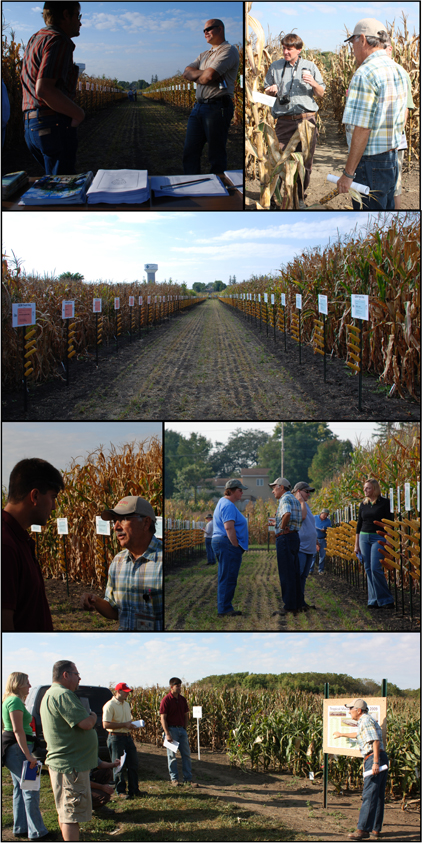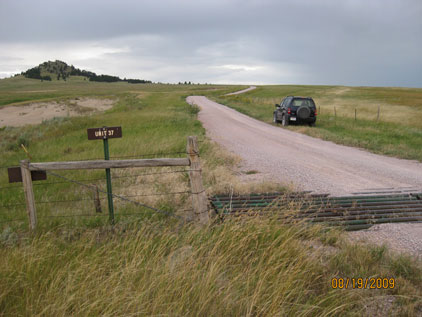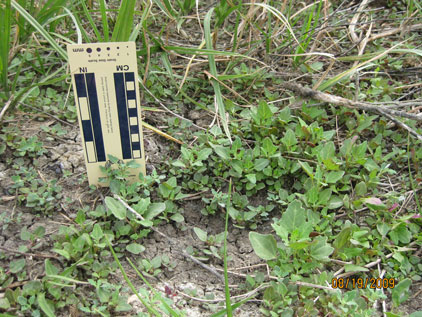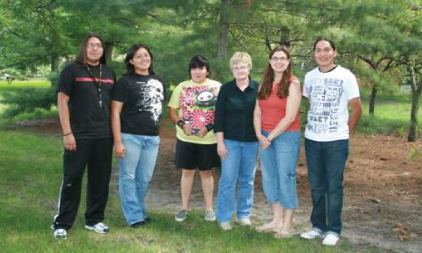| News, Events, and Station Information |

|
|
1 - News, Events, and Station Information
2 - Archived News |

News Items:
- Woody Ornamentals Collection Trip, Ohio, October, 2009
- Ash Collection Trip, Wisconsin - Illinois, August-September, 2009
- GEM Field Days, September, 2009
- Plant Collecting in Western Nebraska, August 2009
- Plant Genome Outreach to Native Americans 2009
Woody Ornamentals Collection Trip, Ohio, October, 2009
2009 Ohio Germplasm Collection Trip
The USDA-ARS Plant Introduction Station (Ames, IA) and the Woody Landscape Plant Germplasm Repository (Beltsville, MD) completed a collection trip to Ohio in 2009. Participants included Jeffrey Carstens, Research Technician, Ames, IA and Martin Scanlon, Research Technician, Beltsville, MD. The objectives were to identify, voucher, and collect germplasm of NPGS genera within Ohio; document Fraxinus germplasm not already represented at the USDA-ARS Plant Introduction Station in Ames, Iowa; store and backup collections at the pertinent active site in the U.S. National Plant Germplasm System and the National Center for Genetic Resources Preservation in Fort Collins, Colorado, respectively; and ultimately conserve and preserve genetic diversity of native, ornamental plant germplasm.Read the full report: 2009 Ohio Germplasm Collection Trip
Ash Collection Trip, Wisconsin - Illinois, August - September, 2009
NCRPIS 2009 Wisconsin - Illinois Germplasm Reconnaissance and Collection Trips
The USDA-ARS Plant Introduction Station (Ames, IA) completed reconnaissance and collection trips to Wisconsin and Illinois in the fall of 2009. Participants included Dr. Mark Widrlechner, Horticulturist, Jeffrey Carstens, Research Technician, and Dr. Luping Qu, Horticulturist. The objectives were to identify and voucher Fraxinus populations and potentially other NPGS genera within Wisconsin and Illinois in 2009; collect Fraxinus germplasm not already represented at the Plant Introduction Station in Ames; store and backup collections at the Plant Introduction Station and the National Center for Genetic Resources Preservation in Fort Collins, Colorado, respectively; and ultimately conserve and preserve genetic diversity of North American Fraxinus germplasm in response to the threat of loss these species from their native range to the emerald ash borer, Agrilus planipennis Fairmaire.Read the full report: 2009 Wisconsin - Illinois Collection Trip
GEM Field Days, September, 2009
GEM Project Hosts Field Days September 17 and 23, 2009
The USDA-ARS Germplasm Enhancement of Maize (GEM) Project hosted two days for Field Days on September 17th, and 23rd at the North Central Regional Plant Introduction Station (NCRPIS) in Ames. Joining the Field Day were members of the GEM Technical Steering Group (TSG) who met on September 16 at NCRPIS and toured the GEM nursery. The TSG consists of research scientists from seven companies in the private sector, two from universities, and three ex officio USDA-ARS members.Over the course of the three days, 67 visitors attended the GEM Field Day from seven states including IL, NE, IN, MO, NC, TX, and IA. The participants included students, corn breeders, food scientists, pathologists, and other agricultural scientists representing 16 companies, five USDA-ARS Research Units (PIRU, CICGRU, PSRU, NCAUR), and four universities (Iowa State, University of Wisconsin, Texas A&M, and Truman State University). Visitors viewed 150 entries of historically important germplasm sources, new GEM inbreds and top crosses developed by the GEM cooperator network, and five new inbreds from Iowa State University. Specialty trait germplasm included value-added grain traits (protein, oil, starch, high amylose, amino acids and silage), foliar disease and mycotoxin resistance, anthracnose stalk rot resistance, and drought tolerance. A tour of the nursery included a discussion of a new shade house (100 feet x 35 feet) that was used to reduce photoperiod response in 100% tropical germplasm. The shade house enabled the GEM team to generate 75 new tropical x temperate crosses for future development, and regeneration of 13 inbreds and 5 populations by the NCRPIS maize curatorial team. In addition, the double haploid nursery was viewed where visitors observed new induction crosses made with 42 races, and first generation progeny rows from induction crosses made with 50 races last year.
GEM's website: http://www.public.iastate.edu/%7Eusda-gem/
Plant Collecting in Western Nebraska, August 2009
Plant Collecting in Western Nebraska, August 2009
In a recent trip, David Brenner and Grace Kostel collected Suckleya suckleyana on the Oglala National Grassland near Crawford, Nebraska. David is a curator at the North Central Regional Plant Introduction Station (NCRPIS) in Ames, Iowa. Grace is an expert botanist and the Herbarium Manager at Black Hills State University in Spearfish, South Dakota. This plant exploration was funded by the USDA-ARS Plant Exchange Office. The Suckleyacollection is part of a larger multi-year project to collect species that are related to cultivated spinach.An unexpected difficulty was encountered in the Suckleyacollection - the seeds were not yet mature. Probably the cool summer and high water this year delayed the plants development. After finding no mature seeds at several locations, plants were dug up for transplanting into a greenhouse back at the station in Ames, Iowa. On return to Iowa, the plants looked well and an adequate seed harvest is expected. This is our first accession of the genus Suckleya.
On the same trip, seeds of Echinacea angustifoliaand Sphaeralcea coccineawere collected for the NCRPIS Medicinal and Ornamental Plants projects. Echinaceais a popular ornamental coneflower that is also used as a medicinal. Sphaeralceais an attractive plant with orange flowers resembling and related to Hibiscus, but in miniature. It is about 6 inches (15 cm) tall.
Suckleya
Suckleyadig-ups EchninochloaPlant Genome Outreach to Native Americans 2009
Outreach to Native Americans
This past summer the North Central Regional Plant Introduction Station joined with the Corn Insects and Crop Genetics Research Unit to welcome four Navajo interns: Thurmon (TJ) Redhouse, Jr., Danielle Charley, Leslie Nelson, and Larry Morris (pictured with Dr. Candice Gardner and Dr. Carolyn Lawrence). Funded as an outreach component of an NSF grant, these interns were recruited by Lawrence and mentored by Lawrence, Gardner, USDA staff, as well as Iowa State University personnel. The group collaborates with the ISU George Washington Carver Summer Minority Internship Program to ensure that the interns' transportation, lodging, meals, and cultural enrichment activities are provided. In addition, Tribal Elders visited the program this summer to learn about what the students are accomplishing and to cast the program within the context of increasing the presence of American Indians that study the modern natural world.To learn more about the interns and their projects, visit: http://www.lawrencelab.org/outreach/2009/GWC.html.
| [1] 2 Next >> |







